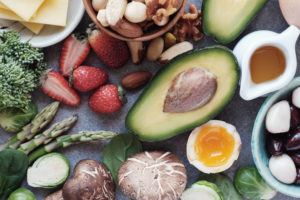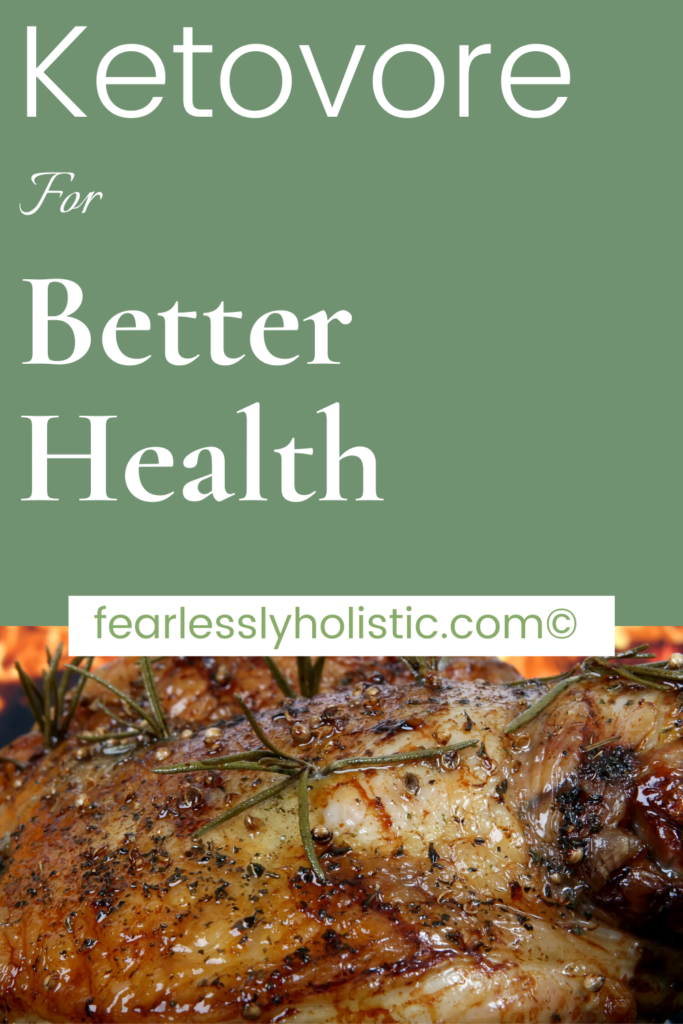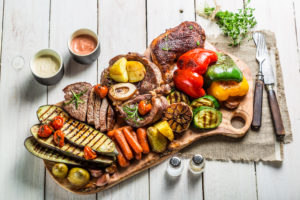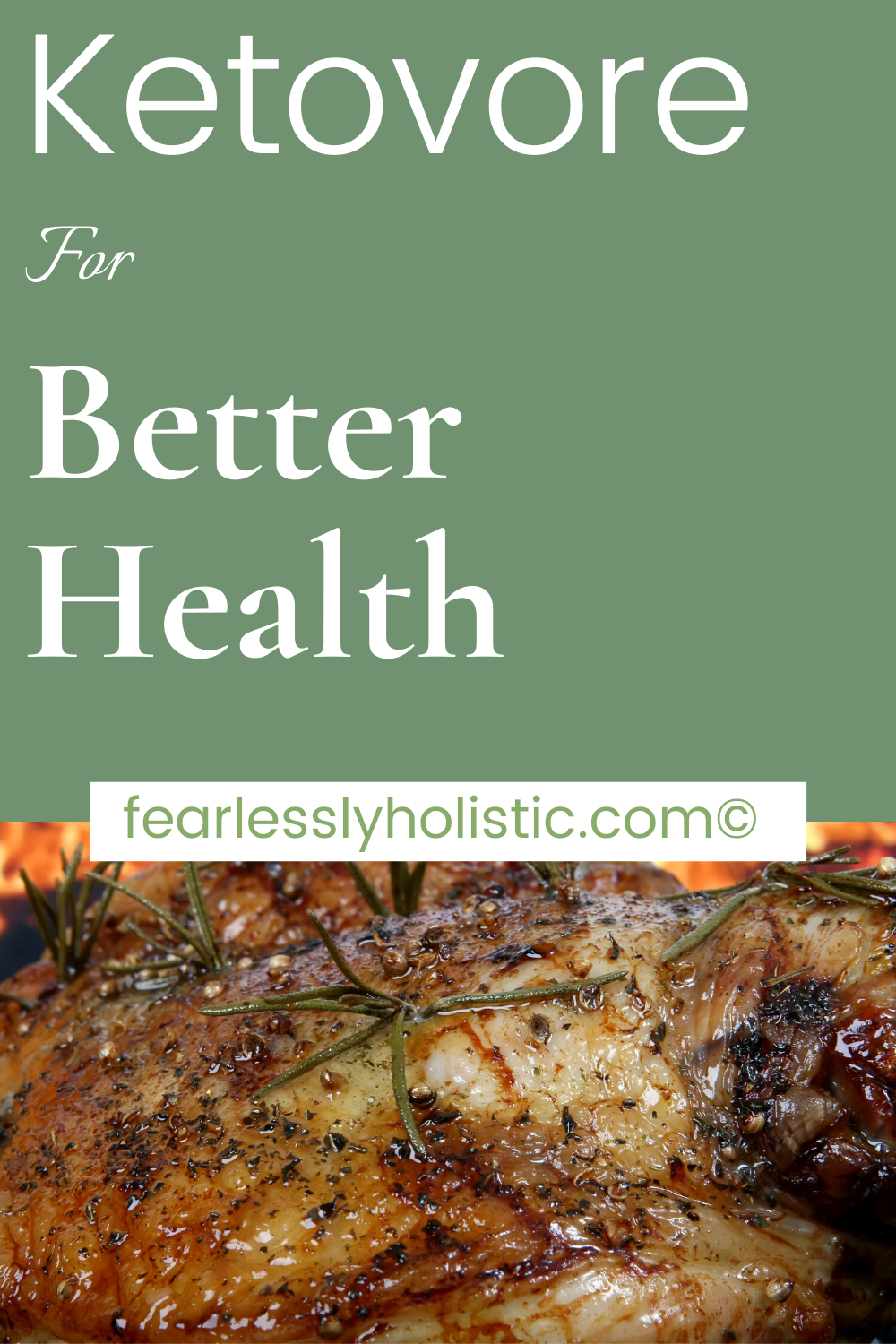Ketovore: a new word in the dictionary! Today we will dissect the Ketovore diet, and there is a lot to unpack.
This post was originally published on January 24, 2020, but has been updated with more information and links to other helpful posts.
- What is Ketovore diet
- Where it came from,
- The benefits of Ketovore
- Ketovore Foods
- Basic Ketovore meal plan
- A bit of info on Intermittent Fasting
- Bulletproof Coffee & Ketovore
- Is Ketovore Healthy?
I try to cover all the bases in this post, so that you are informed and can see why Ketovore is a great option for re-setting health and losing weight.
Hello and welcome to Fearlessly Holistic.
My name is Irma and I want to share my journey to improved health by eating whole foods, moving my body and eliminating stress as much as possible. It is my hope to inspire you to make daily changes. Why? Because eating fresh, seasonal food and getting some sunshine is the best way to increase longevity.
But you do not want just a long life. You want a quality long life. I like to focus on simple concepts and moving forward one step at a time for sustained progress.

If that sounds good to you, then be sure to sign up for my free weekly newsletter of tips for Keto, ketovore, carnivore, healthy foods, gut health, mental health and self-care!
**My blog posts are my opinion and the results of things that I have tried that either worked for me or didn’t. My opinions are for informational purposes only and are not intended as medical advice. Medical advice should always be obtained from a qualified medical professional for any health conditions or symptoms associated with them**
Why Ketovore Diet?

The keto diet is a low carb way of eating that encourages you to eat meat, vegetables (mostly leafy green ones if you follow Atkins Induction, which is similar to Keto), as well as dairy and fat.
Carnivore is straight up meat, eggs and fat, with no veggies and very little dairy (carbs!).
It is also known as very low carb (less than 5 grams of carbs per day) and it is amazing for helping you sort out your health issues!
The Ketovore diet gives you the option to not eat vegetables.
Is eating no vegetables healthy? Of course it is!
I can understand the confusion, because advertising would have us believe that we cannot survive without fresh produce, every day and at every meal.
This is great marketing, but is not normal for humans.
Think about it. Up until the invention of home refrigeration and freezing, you only had limited options for preserving fresh vegetables.
And if humans couldn’t survive without eating vegetables daily, we would have died off as a species long ago.
If you had cold storage in your home, usually a root cellar, you could keep hardy produce over the winter.
- Veggies that keep well in cold storage are mostly root vegetables like potatoes and carrots.
- You could also keep hardy apples and winter pears, like Anjou.
Conditions were not always ideal, but it was helpful.
And this is the reason winter comfort food contains many of these veggies. An example is a beef stew with carrots, potatoes, turnips, and onions.
Same for winter soups: most contain carrots and onions because that is all you had.
People around the world also relied on lacto-fermentation to preserve food as well.
Saurkraut and its Asian cousin Kimchi are examples of fermented vegetables.
Not only did this give you vegetables in winter, it also gave you good bacteria to keep your gut healthy during winter cold months.

So the idea of having a salad during a snow storm is something new for the 20th and 21st centuries.
Humans lived without any fresh food that was not available during its natural growing season for centuries. If it wasn’t dried or pickled, it was off the menu.
Eating strawberries or lettuce out of season means that:
- The fruit was forced to grow
- Much “forced” produce is sprayed with chemicals to get the desired product
- It is mostly devoid of nutrition because of growing conditions
- You pay a premium price because you are supporting farmers half a world away. #eatlocal
The best way to find out what is fresh and in season locally is to check out your local farmers market.
Many also sell organic, so organic and local is the best that you can hope to get if you do not have your own garden.
If you can check out the market weekly as often as possible, you will come to know the natural seasons for many foods. And it is a great place to get fresh, pastured eggs.
The push to eat out of season fruit and veg is not to encourage you to eat your 5 day for health. It is strictly to keep trade between countries moving.
What Is The Ketovore Diet?
I was in a low-carb group when Atkins was the big thing. It was a fun place to hang out, get tips, and lots of recipes.
There were off-shoot groups, like the very low-carb group, who ate less than 5 grams of carbs per day. Pretty much carnivores.
The people in this group did not think that plant foods were critical to life, which is actually correct.
- There are essential amino-acids (from protein)
- And there are essential fatty acids (from good fats)
There are no essential carb foods
However, for some of us, life would be no fun without a salad made from fresh ingredients.
Ketovore was born from this idea, and it is taking the low-carb community by storm.
''Ketovore is eating clean healthy foods, with an option to eat veggies as you feel like it. We recommend eating fresh, local, seasonal produce for the best nutrition'Click To TweetSome people just cannot go a whole week without veggies.
So you could do carnivore for 4 days then have a long weekend where you can indulge in salads and veggies along with meat.
Back when the low carb crowd was following the advice of Dr. Atkins and his book New Diet Revolution (aka DANDR), there was a mysterious section all about the “fat fast”.
Fat fast is part of the chapter on Metabolic Resistance: Causes and Solutions
Some people just have the kind of health issues where they stall for long periods, even on low carb diet, and this section of the book addresses potential solutions. Some of these issues are:
- Candida (yeast overgrowth in the body)
- Insulin is out of whack
- Prescription drugs
- Hormones
- Anti-depressants
- Anti-arthritis medications
- Diuretics and Beta-Blockers/high blood pressure medications
- Thyroid problems
One solution is the fat fast.

Dr. Atkins listed several foods that you could eat in an effort to move the scale. Foods like:
- One ounce of macadamia nuts or macadamia nut butter
- Two ounces of cream cheese or Brie
- One ounce of tuna or chicken salad with two teaspoons of mayonnaise served in one-quarter of an avocado
- Two deviled eggs made with two teaspoons of mayonnaise
- Two ounces of sour cream and two tablespoons of black or red caviar
- Two and a half ounces of whipped heavy cream topped with sugar free syrup
- Two ounces of pate (check label for fat content)
- Two egg yolks (hard boiled) with one tablespoon of mayonnaise
Each of these foods is approximately 200 calories of mostly fat.
You can eat five of the choices per day for a total of 1000 calories.
You should only do the fat fast for a maximum of four to five days.
Dr. Atkins did add a disclaimer that eating this way is actually dangerous if you are not metabolically resistant. Please pay attention to this disclaimer!
Fat Fast was a very popular section of Dr. Atkins book
People were asking questions on how they could adapt parts of it. They were intrigued by the idea of not eating vegetables.
I mean, it is very freeing to just cook meat and add a bit of butter.
Fat is very satiating
The meals would be simple to prepare, but not everyone can eat these foods.
In answer to the people who wanted adaptations, Dana Carpender wrote The Fat Fast Cookbook. I bought it and I make some of the recipes all the time.
Then a different approach started to appear in the low carb forums…meat and egg fast.
Paring down the fat fast to a basic menu of meat and eggs made fat fast easier to understand and implement.
It works for people who cannot tolerate dairy, like me.
It is also a super simple way to kick-start your body into Ketosis, which is your body’s way of using excess body fat for fuel.
My first time, I lost 8 pounds in six days.
You will gain back half of that when you return to eating veggies, so be aware!
However, if you eat carnivore for 5 days a week, and keto for 2, you end up losing weight more than gaining.
Now, meat and egg fast has been renamed, at least on YouTube, as the beef and butter fast.
But whatever name it takes, it makes meal planning a breeze! Especially if you have a Costco membership 🙂
Related Post: Keto Made Easy

What is the benefit to Carnivore/Ketovore/Fat Fast?
Actually, there are a few benefits.
- Easy meal planning. Fry a burger patty, top with butter, eat.
- Eating only one food at a time makes it easy to figure out which foods your body does not tolerate well.
- You are not hungry and for most part, you will have no food cravings. Yup, that is what eating meat and fat does for you.
- Not eating vegetables that are out of season around the world, like lettuce in winter, means less pesticides for your body 🙂
- Shopping is super easy and much cheaper.
Here is a link to a Mikhaila Peterson video. This is a 5.5 minute video of Mikhaila talking about how she put most of her health issues into remission by eating a carnivore diet.
It is a very interesting interview, and the main reason that I opted to go full-on carnivore to try to heal my gut issues.
Mikhaila has a number of auto-immune problems that resulted in her having her first hip replacement and an ankle replacement at the tender age of 17.
Imagine having hip replacement surgery at 17 years old. Crazy!
As I have said, I have gut issues.
I injured my ankle, but had no sick time, so I had to keep working. My doctor gave me painkillers and strong anti-inflammatory meds.
Those pills caused major gut issues for me, which included gut pain after eating pretty much anything. I went for a long time on the poor advice of my doctor.
Read this article by Dr. David Perlmutter or this one from Paleo Leap if you think this might be your problem. For the record, I believe that anti-inflammatory drugs make inflammation worse.
Carnivore diet really helped me in this situation

If I eat eggs for lunch and a pork chop for dinner, those are the only foods that can cause me problems that day.
All I have to do is stop eating those foods for a couple of weeks, then I re-introduce just one of them and monitor whether I have symptoms or not. Easy peasy.
Elimination diets help you to pin-point foods that your body does not like
*Note: You do not have to eliminate foods for life.
Just figure out what food does to your body and choose what to eat depending on your situation. This gives you the control over how you feel.
Some days I just really want a bunless whopper…life is for the living am I right?
In general, I feel better eating a carnivore diet.
I have no brain fog, like I did eating carbs. My hair is shinier and my skin is less dry. I never get headaches any more.
I have started keeping a food journal to make notes on foods that I know aggravate my gut issues. Like that off plan food I ate the other day.
It is detective work, but if you get no satisfaction from doctors you have not choice but to be your own doctor.
I started carnivore three weeks ago, and my gut pain is gone.
I started carnivore diet in January of 2020.
After two years of Ketovore, I basically eat carnivore all winter and into spring. When I can get fresh, local leafy greens I start eating salads again.
My gut is mostly healed.
I just have to monitor foods I eat when I am on my Keto diet days.
What Do You Eat On A Ketovore Diet?
I start with planning meals around carnivore meals.
The easiest way that I have found is to do a big shop for meat and then spend a day prep-cooking.
For example, I will cook a pot roast and cook some hard boil some eggs to keep on hand.
Then, add veggies if you like
The next day, I will heat up some leftover roast and steam some green beans. Or not, it kinda depends on how I feel.
As long as you have meat cooked or easy protein foods like eggs, you can choose what to eat with them.
It is critical to always have food ready to go so that you are not tempted to eat “off plan”.
Eat eggs for supper or eat pot roast for breakfast. As long as you stick to carnivore foods on carnivore days, you are good to go.
Basic Carnivore Menu
I suggest that you sign up with a free, reputable food tracker like Cronometer.
You want a way to track your macronutrients (fat, protein, carbs) so that you can tweak them to find that sweet spot that equals weight loss and improved health.
Cronometer has an app for mobile
And you can link it with Google Health, Apple Health, and many products like Fit Bit.
First meal:
2 eggs fried in butter; 2 breakfast sausages (watch for sugars and starches added to the sausage meat. Seek out clean foods when possible).
Second meal:
Ground meat patty, pan-fried and topped with 1 tbsp. of butter
Third meal:
Half a can of tuna with 1 tbsp or two of good quality mayonnaise. I recommend Chosen Foods Avocado mayonnaise.
This is more than enough food for my day. I can easily skip the keto days and wait until fresh veggies are in season.
If you find yourself hungry on this basic plan, you need to up your fat a bit more.
Use butter or mayonnaise to top your foods.
If you find that you cannot eat that much food, don’t. Eat when you are hungry and just until you are full, then stop.
You may do better with one egg and one sausage link for breakfast. Tweak as necessary.
I buy meat from Costco
The portions are huge and pretty much all the individual servings of meats, like patties and chops, are all at least 8 oz.
Make sure you get enough protein so that your body does not steal any from your muscles (protein catabolism), especially if you work out often.
I also find that loading up on protein for a day or two pretty much kills my cravings.
Basic Ketovore Meal Plan
First meal:
2 eggs scrambled with some heavy cream (to boost your fat intake) cooked in butter; bacon or sausage or some other meat
Second meal:
Half a can of tuna mixed with good quality mayonnaise. Serve with 1 cup of veggies (cooked or salad)
Third meal:
Roasted or grilled meat plus 1 cup of veg.
As you can see, the menu is similar.
You are just adding in 3 cups total of salads and/or cooked veggies to go along with the protein and fat.
When spring comes along, I eat any leafy greens that I can get.
As the seasons move, I switch up the veggies to whatever is in season locally. This ensures that my nutrients are fresh.
If you can find them, try dandelion greens in early spring, or fiddlehead ferns. Whatever grows where you live.
Intermittent Fasting
If you want even more benefits to eating ketovore, add in intermittent fasting.
Intermittent fasting, or IF for short, is increasing the gap between dinner and breakfast the next day.
For most people, if you stopped eating at 6 pm and did not eat until 8 am the next day, you just had a 14 hour fast.
Increasing your fasting time to 16, 18 or even 20 hours has multiple benefits for your body.

What happens with fasting for longer periods is that your body takes the time when digestion has stopped to do some housekeeping.
Your body will recycle damaged or old cells, which means they are no longer floating around inside of you.
This has the effect of improving healing and slowing down aging.
For more information on intermittent fasting and how to get started read>> How to do an Intermittent Fasting Diet Plan
Ketovore and Carnivore diets both make fasting easy
Fat and protein are satiating, which means you can go for a longer amount of time before you get hungry.
Carbohydrate foods on the other hand are quick energy, which is why it is recommended to eat 3 meals and 3 snacks daily.
However a high carbohydrate diet will not give you the opportunity to fast for extended periods because you are starving all the time.
My personal best fasting time is 5 days
I ate a lot of protein for the two days prior to starting a fast, because that much meat gives me the energy to sustain the first day of the fast.
After that, I drink sparkling water, bone broth, and tea.
A 5 day fast was surprisingly easy. I can see why it is recommended throughout history.
The bible talks about it all the time. And the ancient Greek scholars, Hippocates and Plutarch both recommended fasting for pretty much all illnesses.
Consider increasing your daily fast and see the benefits to your body.
Bulletproof Coffee & Ketovore
Bulletproof coffee is coffee is the invention of Dave Asprey, who stole the idea from people in Tibet when he was trekking there.
Dave discovered that adding quality fat to coffee gives the brain a boost of clarity…kind of the opposite to brain fog.
Since Dave’s recipe was a bit on the complicated side, because MCT was hard to find in the early days of Bulletproof, the Keto community adjusted it a bit.

For Keto coffee, add extra virgin coconut oil, plus grass fed butter.
If you use a frother, it almost tastes like a latte and is yummy without sweetener.
FYI: If you have never made coffee like this, start very slowly when adding the fats, and work your way up. Too much fat can have a laxative effect first thing in the morning.
Eating low-carb, and especially carnivore, is filling.
You may find that when you get up, you just are not hungry right away.
Bulletproof coffee is a great way to bridge the time between breakfast and lunch.
And it works well with intermittent fasting.
Alternatively, try a bit of heavy cream in your coffee if you are on your Keto days.
And I still make myself wait until at least 10:30 am before I consider adding calories to my day (i.e the coconut oil or butter in coffee or tea).
My eating window is 12 noon to 6 pm, barring unforeseen circumstances.
Is a Ketovore Diet Healthy?
I still see blog posts written by dieticians calling Keto diet “restrictive”. Which begs the question “restrictive in what way”?
Vegan is restrictive (no meat at all).
Vegetarian is restrictive (almost no meat). I do not count the new lab-grown fake meat; no one knows what the impact of eating that stuff has on your body. Have you seen how it is made? ewwww.
I do not consider removing foods from my diet restrictive is they cause me to feel unwell. No one blames red meat for obesity, but they do blame sugar and carbohydrate foods…
Related Post: The Benefits of the Carnivore Diet
Carnivore and Keto are not restrictive if you understand that the foods that are “restricted” on low carb are the foods that make us unhealthy.
So ya, in the case of Keto diet, restrictive is certainly healthier.
FYI: there are no “essential” carbohydrate foods.
Look it up. Humans can live without grains (pasta, breads etc), potatoes, rice, and produce and survive nicely.
Imagine if the area that you live in is overrun with pests…or if it floods and nothing grows that season…or there is a drought and no water for the crops. Does that kill off an entire population?
Not if you have meat and fish. Crops can fail, but there is usually meat wandering around somewhere.

It may not be ideal, but it is do-able.
What is restrictive is pushing a diet that makes people sick. And then pushing pills on them to treat, but not cure, their health issues. That is restrictive.
Try Googling how many hard-core vegans have switched back to eating meat.
When you get to the point where you will try anything to feel better, many vegans find that they crave meat or fish prior to eating it again.
Read this post. Here is another. And just for the heck of it, you can read this as well.
Vegans who return to eating meat eat ethically sourced, pastured, grass-fed or otherwise healthy meat.
This is good advice for anyone. If you want to be vegan, go for it. Eating a ton of fresh veggies and fruit is good for you…if those foods are in season.
However, if your body requires you to supplement with B12 (critical) , Vitamin D, Omega 3’s, Iodine, Iron (critical), calcium and zinc, then I would call that restrictive.
Related Post: Keto Diet Myths
Conclusion
I hope that I have shown you that Ketovore diet is healthy.
I advocate for clean Keto and Carnivore foods, meaning single-ingredient such as beef or cauliflower. You can totally mix-and-match your single ingredient foods, like when you mix oil and lemon juice to put on a salad.
Eating this way has helped me lose 25 pounds, eliminate joint pain, eliminate candida, and fix a vision problem I was told was not fixable (Astigmatism).

I hope that you have enjoyed this post and please share it with anyone that you think may benefit from it. Sharing is caring!
And follow me on Pinterest!
Until next time, here is to our health!
-Irma



Thank you for this article!! I did a search and actual put What the hell is Ketovore and found this! This was invaluable to read! Again, MUCH thanks to you!
Do you add supplements such as potassium and magnesium? Any others?
Hi Lori and thank you for visiting us!
And thank you for your comment. I have been Ketovore for some time now and I have a free Shopping list for Ketovore that you get when you sign up for my email newsletter. I also have a 2-pack of eBooks on the benefits of Keto & Carnivore and a full kit to help anyone transition to Ketovore.
Ketovore has improved my health immensely. Leg cramps are an indicator, to me, that my electrolytes are off. I either add more salt to my food or take Magnesium.
Hth!
Irma 🙂
I found your article today and I enjoyed the read. The information has been very helpful and well written. I will be adding your information to my game plan.
Hi Tawana and thank you for visiting us today,
And I am so happy that you enjoy my content. Please let me know if there are specific topics you may want more information on!
Cheers,
-Irma 🙂
Hi Irma,
Thanks for helping explain ketovore for me. I’m finding that it’s really heard to go zero carb because I still eat dairy and some just inevitably have carbs. But I have no intentions of eating plants. I’m allergic to every plant under the sun it seems, so to heck with them, right? lol
I’m working towards ketovore from just a high protein/low sugar yet standard diet (I’ve been trying to recomp so protein led me in this direction). I have been taking a lot of supplements over the years but my specific question is–do I need to be taking NAD+ anymore? I’ve recently learned that the reservatrol supplement I’ve been taking may be doing me more harm than good with so many plant aspects to it, so when I started reevaluating my supplements I got to wondering about this NAD+. It says that it’s for improving cellular energy, but I’m no scientist so I have no idea how that really fits into all of this.
If you’re not sure, perhaps you could even point me in the right direction?
Thanks,
Karen
Hi Karen!
Thank you for visiting us. You sound like me…I always have a ton of supplements on the go. I am no scientist either, and I am finding that there is no one-size-fits-all in any aspect of health because we all have unique health issues.
I do not know why you take the supplements you take, or what else you are taking, so I suggest that you cut back on pretty much everything you don’t physically need and start with a clean slate.
This does NOT include prescription meds. Do not stop taking any life-saving meds.
Because I have done this myself, with decent results, I do recommend doing an elimination diet/carnivore diet. If you want to eat dairy, do a very low carb diet (VLC = 5 grams or less of carbs per day). The reason for stopping supplements is that they may have ingredients that interfere with your healing right now. When you feel better, add them back in one at a time and monitor any symptoms (like hayfever, sneezing etc).
And do a 3 or 5 day fast and see if that helps. I did a 5 days fast (to force myself to stop dairy just so I could add it back and monitor the results) and it helped me get rid of the last of my Candida.
If you are new to fasting, I suggest Dr. Jason Fung’s book “The complete guide to fasting”. If you are already in ketosis, it is pretty easy to fast, and the longer you can go the better. Get some sparkling water, make some bone broth and get to it.
I have experimented a lot over the years, but I did not get the overall health benefits that I wanted until I eliminated everything and started from scratch. I think that is because it is hard to tell what is working and what isn’t when you eat multiple foods per day.
Once you narrow down the list of foods you eat, it gets easier to see where problems are.
I think eating seasonal and local produce is best for my body because I get a variety of nutrients throughout the growing season, and I have read the same about other people, so I think there is value in considering this option.
But I do not like veggies except for salad greens, so I do allow myself to eat cherries and peaches in summer to pick up some nutrients that way. I think it is important to grab those seasonal nutrients to give out body building blocks for a winter of a meat-only diet.
I cannot point you to help with your supplements because I tragically do not trust supplement advice online. I find that there are too many conflicting opinions, which is why I do my own experiments.
But eating clean food, mostly meat and some seasonal produce, and doing several fasts per year has given me the most improvements. I drink apple cider vinegar in water (using a straw) before meals, and I take a probiotic to help my gut heal. Other than that, I monitor my foods and keep track with a food diary.
I hope this helps you in some way and I wish you much success with your health 🙂
-Irma
I’m curious. You mentioned eating in season and that you really wouldn’t have a green salad in the winter. Are you mainly focusing on climates that have all four seasons? I travel a good deal to countries that are tropical and countries, believe it or not, that don’t have the “meat” sources such as cattle, pig, big game, and some that are limited on chickens where eggs are rare. Their main source of food is plant and plant-based and if they live by bodies of water, seafood of sorts.
So how would they fare in eating this way? Your post seems absolute, I’m just curious as to how it fits for the global community.
Hi Sarah and thank you for visiting us today,
The intent of my comments is to encourage people to eat produce that is growing naturally in its own growing season. I would encourage you to eat whatever fresh, local produce you can get along with the local variety of protein. This should give you optimal nutrition providing you do not have specific requirements.
Eating seasonally is different than buying produce from another country that has been force grown or that is sprayed with pesticides for transport around the world, such as strawberries in January. I do not encourage this because of the pesticides and long shipping times equals less nutrition.
Right now in North America, there is a big push on to get people to eat half a plate of fruit and veggies every meal. So even if the produce has no nutrients, guidelines encourage people to eat it. This seems pointless…to just eat fruit and veggies “because”.
The point of eating seasonally is that there are a variety of nutrients all through spring, summer, and fall plants and so eat progressively of all the produce available where you live will give you a well-rounded amount of nutrients to build up your health for seasons where food is limited.
I hope that helps to explain my position. I know there are plenty of people who live in the tropics and get access to different foods, but I cannot speak to that since I live in Canada.
I believe that it is easier to heal health with fresh nutrients.
Cheers,
-Irma xo
Hello friend! It’s been a long while. I received your latest newsletter from your FearlessAffiliates site and some how found my way here, to your article on ketovore diet! What an amazing, well written piece! It’s full of some serious, in-depth information, and tons of inspiration!! I’m thinking that I’ll put it to the test and see what happens 🤗. I was wondering about seasoning the meat other than just butter on carnivore days. Like spices, salt and pepper… or are those only for ketovore days? Anyway, thanks for the awesome read. I will read on as I pass this particular one on to my daughter. Stay well. I look forward to chatting again soon.
Hi Paula!! So good to hear from you 🙂
You can do carnivore any way that works for you. Some people eat dairy (cheese, cream), while some are hardcore and only eat beef and salt. I think what makes carnivore so effective is that you are cutting back the number of ingredients that you eat. Some of the lab created additives in processed foods cause inflammation, so carnivore allows the body to do some healing.
I eat seasonally now, so I try to eat whatever grows locally and in-season to get the freshest nutrients. It certainly cuts back on my shopping!
Let me know how your daughter gets on with carnivore! It really makes eating so simple and I get a lot of health benefits from it!
Cheers,
Irma xo